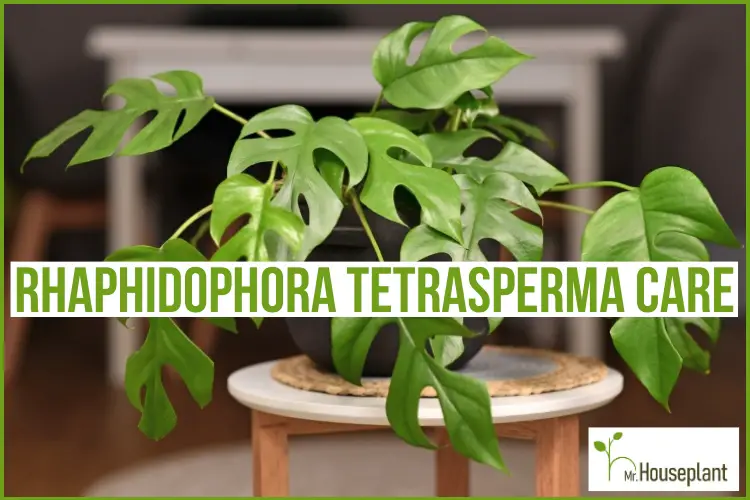
Would you like to learn more about Rhaphidophora Tetrasperma care? What is the proper temperature or humidity for this plant? How to propagate or prune it? Keep reading to find out all the answers and information about toxicity, light, watering, repotting, and other care requirements.
| Botanical Name (Latin Name/Scientific Name): | Rhaphidophora Tetrasperma |
| Common Name: | Mini Monstera |
| Light: | medium light (750 lux – 3,500+ lux) |
| Watering: | once the top 2 inches of the soil are dry |
| Soil: | well-draining mix |
| Repotting: | Once a year |
| Temperature: | 65°F to 75℉ (18°C to 23°C) |
| Humidity: | adapts well to any humidity |
| Toxicity for Pets: | Yes (mouth, tongue, and lips burning and irritation, excessive drooling, vomiting, difficulty swallowing) |
| Toxicity for Humans: | Yes (a tingling or burning sensation, followed by swelling of the lips, mouth, and tongue) |
| Propagation |
|
| Pruning: | Prune dead or diseased growth or when you want the plant to branch out |
Light Requirements
| Minimal amount of light: | 750 lux (75 FC) |
| Optimal amount of light: | 3,000+ lux (300+ FC) |
| Direct sun tolerance: | 2-3 hours |
| Category: | medium light |
One of the key elements in taking proper tetrasperma care is to provide your plant with sufficient bright, indirect light, so it’s best to place it in front of a window. Its minimal light requirement is 750 lux (75 FC), but it will do much better with 3,000 lux (300 FC). It can handle a couple of hours in direct sunlight. The more indirect light you can provide, the better. With more indirect light, the plant will photosynthesize more, grow faster and be healthier.
If you expose your Rhaphidophora Tetrasperma to direct sunlight, it’s best to do it early in the morning, while the sun is not too strong. If you don’t have a sunny spot in your home, you can supplement your light to allow their Mini Monstera to thrive.
Water Needs
Rhaphidophora Tetrasperma is a tropical plant; therefore, it’s used to moisture and humidity. If you want your Mini Monstera to thrive, you need to know one of the most vital rhaphidophora tetrasperma care tips — regular watering.
Typically, you should water the plant once you notice that the first couple of inches of the soil are dry.
Don’t have a strict watering schedule, as the watering schedule will differ for each person and depend on your plant and your environment. A plant might take 2 days to dry out in one person’s home because it’s bright and has low humidity. And it might take 2 weeks in another person’s home because it is a low-light home with high humidity.
Once you’ve had the plant for a certain amount of time and you see how long it takes to dry out in your home, you can start sticking to certain watering days.
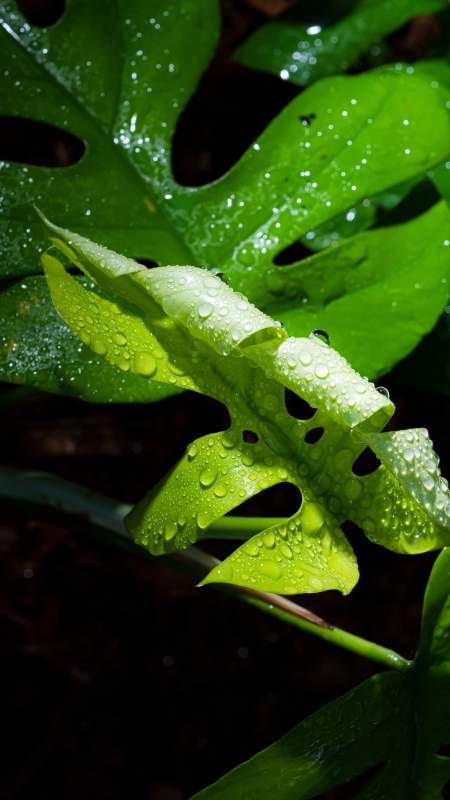
Try to keep track of how long your rhaphidophora tetrasperma takes to dry to calculate when the next watering day should be
Humidity Needs
Being a tropical plant, Rhaphidophora grows in high humidity in its natural habitat, but like most indoor plants, it adapts very well to low humidity. It will love humidity over 50-60%, but it will grow well even if you have low humidity of 10-15%.
Temperature Requirements
The best temperature for Rhaphidophora Tetrasperma growth is between 65°F (18°C) and 75℉ (23°C). Mini Monsteras are tropical plants, and therefore, they’re used to higher temperatures and humidity.
Fertilizing
If you repot your rhaphidophora regularly, there is no need to fertilize, as fresh soil contains sufficient nutrients for your plant.
If you do want to fertilize, you can still do it. Make sure only to fertilize if your plant is actively growing and to follow fertilizing frequency and other instructions on the packaging.
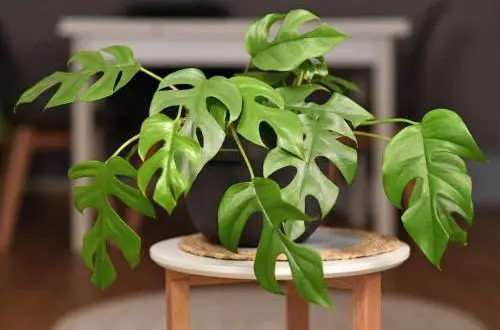
If you’re looking for an attractive, low-maintenance plant, rhaphidophora tetrasperma should be the next addition to your indoor landscape
What Is the Best Rhaphidophora Tetrasperma Fertilizer?
Another key thing in rhaphidophora tetrasperma care is using an adequate fertilizer. My typical choice is the Sill fertilizer as it has a great NPK ratio od 9-3-6, which is excellent for foliage plants.
Soil
When it comes to the Rhaphidophora Tetrasperma soil requirements, the plant is not needy, but it should have soil with good drainage. It prospers the best when using a soil mix with at least 30% perlite that will improve the drainage.
Roots absorb oxygen and release carbon dioxide. Adding amendments to soil creates macropores in the soil, and macropores hold oxygen. Oxygen is very important for the roots. Having macroprose with oxygen reduces the chances of root rot. Adding amendments also reduces soil compaction.
Repotting
Frequently, tetrasperma care includes repotting the plant once it outgrows the current pot. If you follow these simple steps, you should have no issues with the Rhaphidophora Tetrasperma repotting process:
- Cut out the current pot
- Use a bonsai rake to remove excess soil
- Untangle and trim the roots
- Make the new potting mix in a larger pot
- Place the plant inside the pot and pour additional soil mix over it
- Add sufficient water
Toxicity To Humans
Rhaphidophora Tetrasperma is toxic to humans. Children’s Health Queensland Hospital and Health Service confirms that each part of this plant is toxic. If ingested, it can cause a tingling or burning sensation, followed by swelling of the lips, mouth, and tongue.
Toxicity To Pets
Rhaphidophora Tetrasperma is toxic to pets. Since this plant belongs to the Araceae family, the American Society For The Prevention Of Cruelty To Animals (ASPCA) confirms that it can cause symptoms such as mouth, tongue, and lips burning and irritation, excessive drooling, vomiting, and difficulty swallowing.
Pruning
Rhaphidophora Tetrasperma care also includes pruning, although there’s no need to prune a healthy plant. If your Mini Monstera has sick, diseased or dead leaves or stems, that’s a sign that you should prune it.
You can also prune a stem or pinch it if you want your plant to branch out below the cut.
Propagation
If you’d like to know how to propagate Rhaphidophora Tetrasperma, I got you covered. Although the propagation process might seem complicated, it’s pretty straightforward if you follow simple instructions and tips.
- You cannot propagate a single Rhaphidophora leaf, and instead, you’ll need a node
- It’s easier to propagate cuttings with aerial roots
- You can propagate in both water and soil to your preference
- When propagating in water, it’s helpful to add an air pump as the roots need oxygen
- When propagating in water, it’s also beneficial to add a heat mat as heat promotes propagation
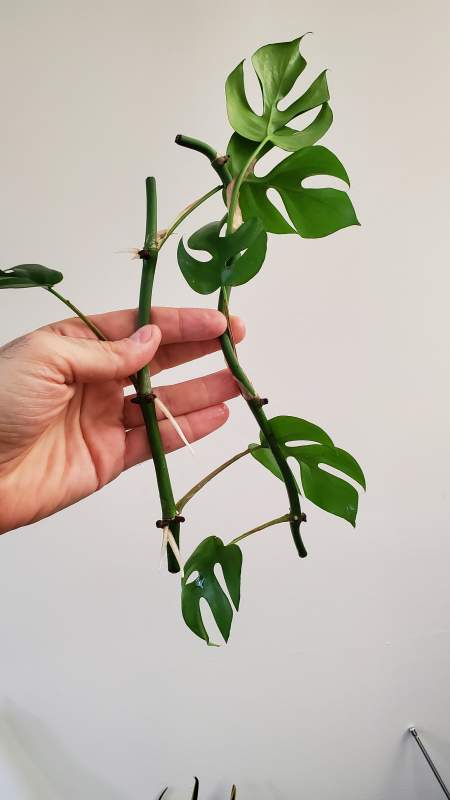
You need to propagate a node instead of a single leaf
FAQs about Rhaphidophora Tetrasperma
Why are Rhaphidophora Tetrasperma leaves not splitting?
There are two main causes behind your Rhaphidophora Tetrasperma leaves not splitting:
- Young leaves — When you have new cuttings, the first leaf or a couple of first leaves might not split as the plant is still young.
- Adult plants with insufficient sunlight — Typically, adult plants have more splits than young plants. However, if your Rhaphidophora Tetrasperma doesn’t have leaf splits, it’s probably not receiving enough sunlight. Similarly to Monstera plants, Raphidophora won’t split when there is insufficient sunlight.
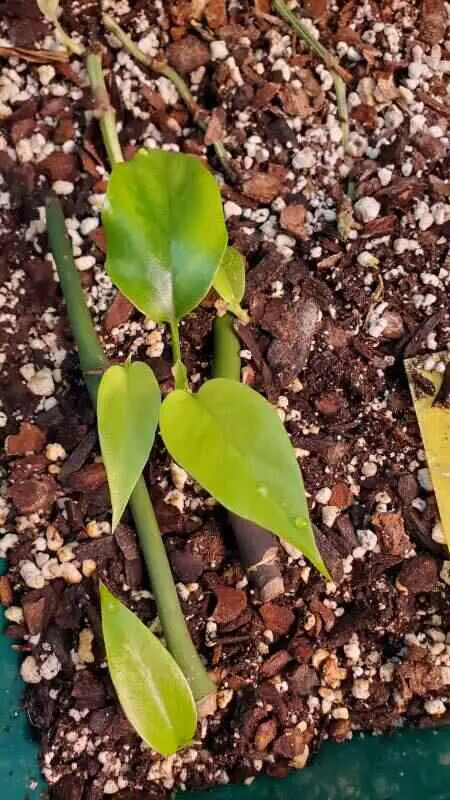
Young leaves on a new rhaphidophora tetrasperma cutting often won't have splits
Is Rhaphidophora Tetrasperma a Monstera?
Rhaphidophora Tetrasperma is not a Monstera but an entirely different species. However, many people can mix it with a Monstera due to their similar appearance. Other than that, they don’t share many similarities, so it’s essential to differentiate the two specimens.
Why are my Rhaphidophora Tetrasperma leaves curling?
When you notice the leaves of your Mini Monstera are curling, it means you’re not providing the plant with proper care. There are a couple of different reasons why the leaves of this plant might start curling:
- Overwatering / not watering enough
- Not enough light
- Insufficient humidity
- Low temperature
How Do You Get Rhaphidophora Tetrasperma Plant To Climb?
Rhaphidophora Tetrasperma is a climbing plant that you can train to climb up a support – trellis or a moss pole. The plant produces aerial roots that attach themselves to the support. You can train the plant to climb by gently tying the stems to the support. The plant will produce new growth that should continue to climb the trellis or moss pole.

With proper training, your rhaphidophora tetrasperma can become an excellent climber
Why Is My Rhaphidophora Tetrasperma Droopy?
There are a few reasons your Rhaphidophora Tetrasperma plant might be droopy. One possibility is that it’s not getting enough water. Make sure you’re watering it regularly and giving it enough water.
Another possibility is that you have been overwatering the plant for a prolonged period of time. As a result of overwatering, the roots can rot, so the plant won’t have anything to absorb the water with. So even though you think you’re providing the plant with enough water, the plant will be unable to absorb water and will become droopy.
Another possibility is that it has root pests or diseases which can damage the roots making the plant unable to absorb moisture.
What’s the Difference Between Monstera Deliciosa and Rhaphidophora Tetrasperma?
Monstera deliciosa and Rhaphidophora tetrasperma plants are two different plant species/two different plants. They are both popular houseplants. They are both easy to care for and are tolerant of a wide range of growing conditions. However, there are some key differences between these two plants.
Monstera deliciosa is a large, climbing plant. It has large, glossy leaves with deeply cut lobes. The leaves of this plant can grow up to 2 feet long. The plant produces small, white flowers which give way to edible fruit.
Rhaphidophora tetrasperma is a smaller climbing plant. It has leaves that are much smaller than those of Monstera Deliciosa. The leaves of this plant are usually only 2-3 inches long.
Yours Truly,



Related Posts
Sansevieria Black Gold (Snake Plant Care GUIDE!)
Spathiphyllum Sensation (FULLY Explained!)
Alocasia Stingray Care